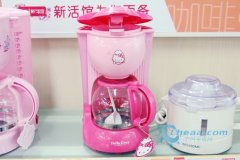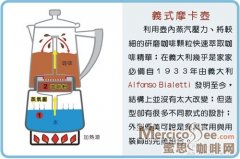Introduction of common espresso (Espresso) brewing appliances

The so-called Italian espresso, which is often called Espresso, has been very popular in Taiwan in recent years. In fact, what is really popular is not all Espresso, but all kinds of coffee derived from Espresso. Espresso refers to the roasting method of coffee beans and coffee, which can be more explained as the brewing method of coffee, which uses high pressure to let hot water quickly pass through the coffee powder. A method of extracting the essence of coffee in a short period of time.
The machines used to make Italian coffee range from the early completely manual operation of the pump to the simple mocha pot to the emergence of many semi-automatic and fully automatic machines thanks to technology.
Mocha pot
In the average family, the more economical choice is the mocha pot, and its quite personalized shape is beautiful and does not take up space, so it is also very popular. In the early days, the material was mostly made of aluminum, but now it is mostly made of stainless steel, which is more harmless to the human body.
Step 1, select Espresso-specific coffee beans, which need to be ground more finely than American coffee, but not to the extent of the powder, which is still granular. If the coffee is ground too fine, the coffee powder will penetrate the metal filter, leaving residue, and cause excessive extraction and too bitter, too astringent, if the grinding is too coarse, the hot water passes through the coffee too quickly and the extraction is not enough.
Step 2. Put an appropriate amount of hot water at the bottom of the mocha pot (usually the amount of a cup of Espresso will not exceed 60 grams).
Step 3, put the coffee powder in the middle of the mocha pot, in a funnel-shaped container, the dosage of each cup is about 8 or 9 g, spread the coffee powder flat, squeeze it slightly, but do not press it too closely, and then put it into the pot.
Step 4: tie the upper seat of the mocha pot to the lower seat completely to ensure that the water does not ooze from the middle when boiling, and then heat the mocha pot from the bottom, which you can hold by hand or on a special shelf, which is heated by an alcohol lamp or gas stove until the water boils and flows to the upper seat.
This is a method that is quite suitable for individuals to use, but its disadvantage is that it is easy to have residue, but now a special round filter paper can be bought on the market, which can be placed between the coffee powder and the upper seat filter to improve the situation. Another point is that the pressure it produces is not enough, so the coffee made can not be called Espresso.
Semi-automatic Italian coffee machine
The so-called semi-automatic means that the filling of coffee powder must be operated manually and the rest is controlled by machines. in fact, this is also a key to the whole Italian coffee. In terms of semi-automatic coffee machines, we can be divided into home appliances and business types:
Home appliance Italian coffee machine
Now many home appliance manufacturers have launched home-type Italian coffee machines, with prices ranging from a few thousand yuan to tens of thousands of yuan.
Italian coffee maker for business use
They belong to larger machines with prices ranging from more than one hundred thousand to hundreds of thousands. The difference between the two lies in whether the pressure provided by the machine is sufficient. The standard pressure is the atmospheric pressure of nine millibars. Although small household appliance machines are constantly improving, they are subject to cost, so the pressure it produces is still questionable.
First, choose Espresso coffee beans and grind them into a finer powder.
Point 2, the weight of each cup is about 8 or 9 g, put it in the brewing machine on average, press the coffee powder with a filler, rotate it about 1 inch 4 times at the same time, apply the force as evenly as possible, and tap the edge of the brewer with a filler, knock down the powder attached to the edge, and then fill it until the coffee powder is pressed flat.
The final key to the success or failure of a cup of espresso is whether the coffee powder can be filled evenly and properly. Like the mocha pot in front, the pressure is too strong, so that the hot water is not easy to pass through, and the extraction time is too long, which makes the coffee too bitter. The pressure is loose, and the hot water will directly run through the coffee, resulting in insufficient extraction. In addition, this is one of the keys to the emergence of Klima. Therefore, the technical experience of the operator becomes the biggest variable.
The so-called "Krima" Crema refers to the golden foam on top of the Italian coffee Espresso (note: it is not the foam on top of the cappuccino or latte), which is often used as a criterion to judge whether the Italian coffee is fresh and successful.
Point 3, tie the brewer, press the switch, you can judge from the speed of coffee flow, whether the filling of coffee powder is standard or not, if it drips slowly, it means that you fill it too tightly, and if it runs out very quickly, it is too loose.
Fully automatic Italian coffee machine
Fully automatic refers to the supply of water, the temperature of water, the amount of water, the pressure of water, the amount of coffee, the thickness of ground coffee beans, filling coffee powder, brewing and pouring coffee grounds, all of which are automatically controlled by the computer, as long as the computer is set up. Buttons can operate without any technical problems. At present, small machines are less than 80,000 yuan. The machines used in large-scale business range from three or 400000 to five or 600000, and the biggest difference lies in the speed at which coffee is supplied when in continuous use.
Important Notice :
前街咖啡 FrontStreet Coffee has moved to new addredd:
FrontStreet Coffee Address: 315,Donghua East Road,GuangZhou
Tel:020 38364473
- Prev

Huijia KD-60B HelloKitty Styling Coffee Machine HelloKitty Star's Favorite
KD-60B is a coffee machine produced by Huijia United HelloKitty. It has a lovely appearance with HELLO KITTY and adds a lot of points. 4 cups capacity, ready to drink, convenient and fast. Heat resistant glass design, safe and durable. Huijia KD-60B coffee machine adopts anti-drip system. Permanent filter, permanent use, environmental hygiene. Heat insulation bottom plate, unfinished coffee, can be placed
- Next

The structure and working principle of mocha coffee pot
Related
- Detailed explanation of Jadeite planting Land in Panamanian Jadeite Manor introduction to the grading system of Jadeite competitive bidding, Red bid, Green bid and Rose Summer
- Story of Coffee planting in Brenka region of Costa Rica Stonehenge Manor anaerobic heavy honey treatment of flavor mouth
- What's on the barrel of Blue Mountain Coffee beans?
- Can American coffee also pull flowers? How to use hot American style to pull out a good-looking pattern?
- Can you make a cold extract with coffee beans? What is the right proportion for cold-extracted coffee formula?
- Indonesian PWN Gold Mandrine Coffee Origin Features Flavor How to Chong? Mandolin coffee is American.
- A brief introduction to the flavor characteristics of Brazilian yellow bourbon coffee beans
- What is the effect of different water quality on the flavor of cold-extracted coffee? What kind of water is best for brewing coffee?
- Why do you think of Rose Summer whenever you mention Panamanian coffee?
- Introduction to the characteristics of authentic blue mountain coffee bean producing areas? What is the CIB Coffee Authority in Jamaica?

